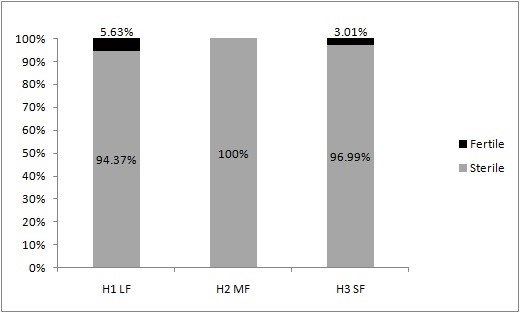Abstract
Dicksonia sellowiana Hook. (Dicksoniaceae) is target of extractive exploitation and is threatened with extinction. We analyzed the population structure, the spatial distribution pattern of D. sellowiana and its relationship with environmental parameters within three fragments of Araucaria Forest in Rio Grande do Sul, Brazil. The fragments are of different sizes, namely, large (H1LF) with 246 ha, medium (H2MF) with 57 ha and small (H3SF) with 5.2 ha. Within each site, 1 ha was delimited, divided into 100 subplots (100 m2), of which 20 were selected with a draw. In each subplot, counting of the individuals, the registration of the caudice height and the coverage of leaves (SC) (m2), measurements of photosynthetically active radiation (PAR), canopy opening degree (CO), soil moisture (SM) and litter thickness (LT). The temperature (T) was measured inside each site. A total of 792 plants were sampled, of which 551 were concentrated in H1LF, 108 in H2MF and 133 in H3SF. An average of 1320 ha-1 individuals were estimated. Of the total including the three fragments, 96.9% of the individuals are in the first class of height (up to 0.8 m), indicating a great potential of population development. The spatial distribution pattern (AI) was aggregated in the three populations and the plants presented a heterogeneous total coverage, between 4.73 m2 (H2MF) and 2,223.47 m2 (H1LF). The highest values of SC and SM were more related to the distribution of individuals in H1LF whereas the opposite was recorded in H2MF. The highest values of PAR, LT and CO correlated with the distribution of D. sellowiana in H3SF. In addition to revealing that the H1LF population is among the most dense in southern Brazil, the results demonstrated a significant structural distinction between the interior populations of the fragments, in spite of them being located near to one another and being part of the same natural field matrix.
Keywords:
fragments; bioindicators; environmental variables; canopy opening

 Thumbnail
Thumbnail
 Thumbnail
Thumbnail
 Thumbnail
Thumbnail


